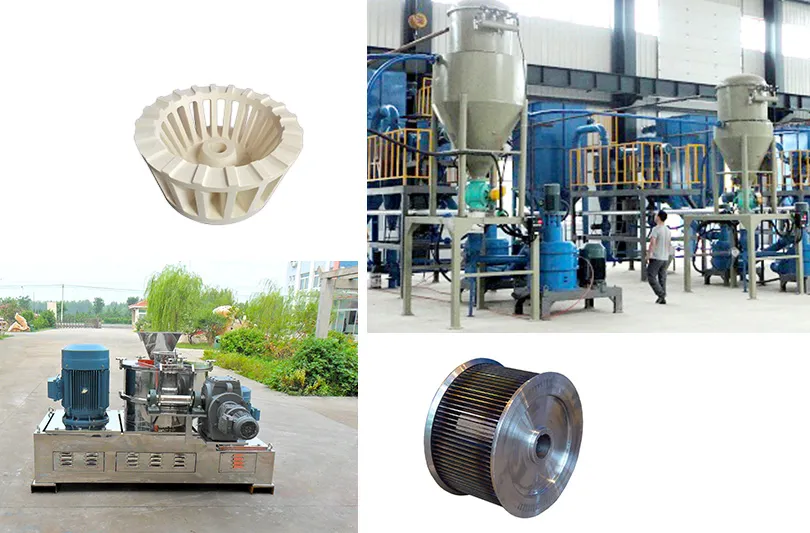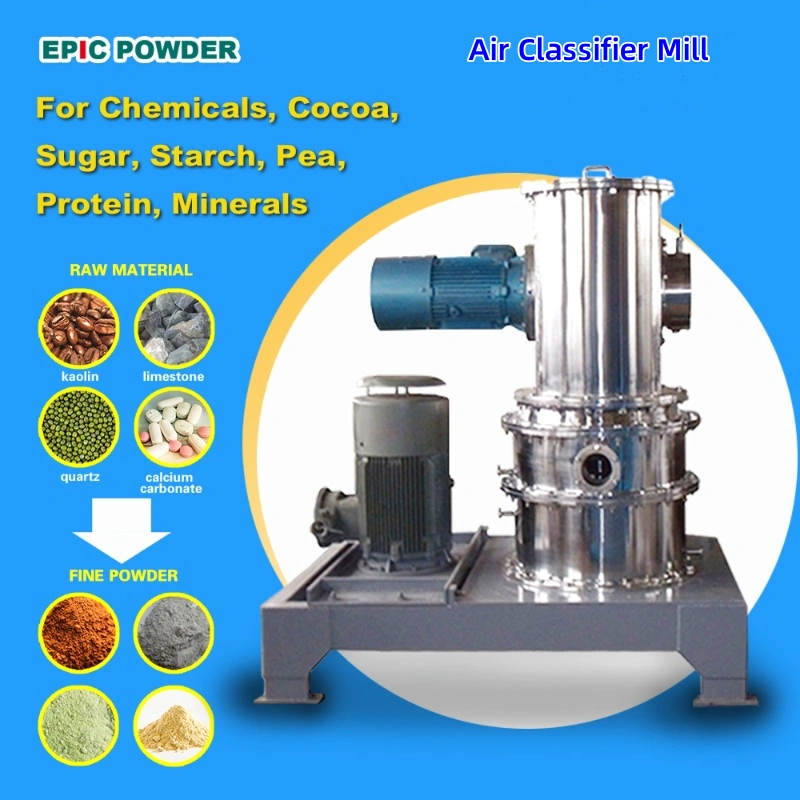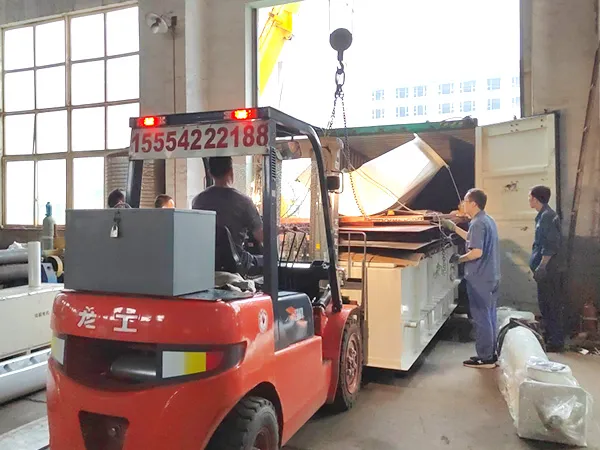An air classifier mill utilizes high-speed rotating components — such as hammers, blades, or rods — to impact the material being ground.
Through the intense collision between the rotor and the particles, the high-speed impact among flying particles, and the shearing and grinding between the rotor and the stator or chamber wall, the material is efficiently reduced to ultrafine powder.

Equipment Features
De EPIC Powder mechanical ultrafine air classifier mill offers six major performance advantages:
- Suitable for soft materials
Designed for ultrafine grinding of materials with a Mohs hardness below 3.5. - Adjustable and finer particle size
Equipped with a built-in high-efficiency turbo classifier, the system allows immediate discharge of qualified fine powder, preventing over-grinding.
It produces a sharp particle size distribution curve, with adjustable product fineness ranging from d97 = 10–74 μm. - Automatic impurity discharge
The grinding chamber features an automatic slag removal system, which discharges hard impurities or ungrindable particles automatically. - Agglomerate dispersion capability
Effectively disperses and de-agglomerates materials, improving powder flowability and uniformity. - Cooling and temperature control
High air throughput ensures cool grinding, ideal for processing heat-sensitive materials without agglomeration or deposition. - Clean and safe operation
Operates under a fully enclosed negative pressure system, preventing dust leakage and ensuring a clean working environment.
Application Scope of Air Classifier Mill

The EPIC Powder Luchtklasseermolen is widely used in industries requiring high purity and precise particle size control.
| Industry Field | Typical Materials | Application Advantages |
|---|---|---|
| 1. Non-metallic Minerals | Hard kaolin, talc, graphite, calcite, gypsum, diatomite, wollastonite, barite, pyrophyllite, aluminum hydroxide; ultrafine/nano materials such as nano calcium carbonate and cerium oxide. | Achieves ultrafine grinding and efficient dispersion of mineral fillers, improving filler performance. |
| 2. Heat-sensitive Materials | Lactose, wax, resin, fat, bone meal, plant extracts, etc. | Enables low-temperature grinding, preventing heat degradation or sticking while maintaining active components. |
| 3. Herbal and Food Materials | Pollen, hawthorn, shiitake, pearl powder, ganoderma, gallnut, polygonum multiflorum, andrographis, mint, houttuynia, fern root, kudzu root, isatis root, etc. | Enables ultrafine processing of herbal materials, enhancing bioavailability and dissolution rate. |
| 4. Chemicals and Other Applications | Pigments, dyes, polymers, and specialty chemicals. | Achieves fine and uniform grinding to meet high-quality product requirements. |
Comparison Between Air Classifier Mill and Jet Mill
| Functie | Lucht Classifier Mill (Mechanical Impact) | Jet Mill (Air Jet) |
|---|---|---|
| Grinding Mechanism | Mechanical impact, shearing, particle-to-particle collision | Particle-to-particle self-collision, air stream shearing, wall friction |
| Energy Consumption | Lower; uses direct mechanical energy from rotor, with higher energy utilization | Higher; consumes large volumes of compressed air or steam |
| Material Hardness | Suitable for soft to medium-hard materials (Mohs ≤ 3.5) | Suitable for very hard and abrasive materials (Mohs ≤ 9 or higher) |
| Particle Shape | Irregular or angular due to impact and shear; some surface stress | Near-spherical particles due to self-collision; lower internal stress and narrower size distribution |
| Product Fineness | Adjustable between d97 = 10–74 μm | Achieves d97 = 3–10 μm or even submicron/nano levels |
| Wear & Contamination | Wear concentrated on impact parts; possible metal contamination with hard materials | Minimal contamination; wear mainly at nozzles and outlets |
| Temperature Control | Cooling effect from high airflow; suitable for heat-sensitive materials | Gas expansion also provides cooling; suitable for heat-sensitive materials |

Conclusie
The EPIC Powder Air Classifier Mill represents a new generation of integrated ultrafine grinding and classification technology.
It combines mechanical impact, dynamic classification, and efficient cooling to achieve precise particle size control, high productivity, and clean operation.
Whether for non-metallic minerals, polymers, food additives, or herbal materials, this system delivers products with a narrow particle size distribution, stable performance, and consistent quality.
With over 20 years of experience in ultrafine powder engineering, EPIC Powder continues to provide customized solutions, helping customers achieve higher grinding efficiency, purer product quality, and greater market value.

